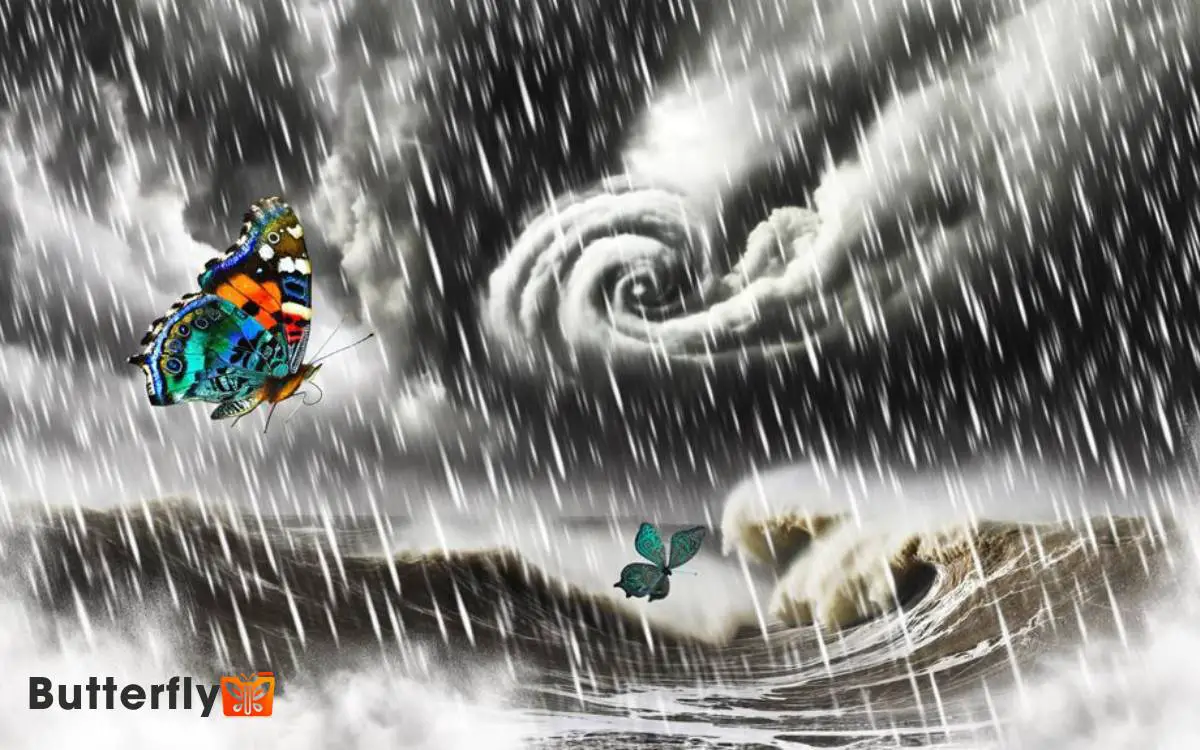Can Butterflies Fly Through a Hurricane? Discover!
You might think butterflies can fly through anything, but hurricanes are an exception. Their delicate wing structures, made of chitin and intricate veins, can’t handle the extreme turbulence and high wind speeds of a hurricane. Even moderate winds can push them off course.
During such storms, butterflies seek sheltered microhabitats to conserve energy and avoid injury.
Historical encounters confirm this species like Monarchs and Painted Ladies have survived hurricanes by finding refuge. There’s much to explore about their remarkable resilience and survival mechanisms.

Key Takeaways
Anatomy of Butterfly Wings
Although delicate in appearance, butterfly wings are intricately structured with layers of chitin, scales, and veins that enable flight and thermoregulation.
The chitin provides a lightweight but strong framework, essential for maintaining wing integrity.
Covering this framework, scales create the vibrant colors and patterns you see, aiding in camouflage and mate attraction.
Veins running through the wings play a vital role in distributing nutrients and fluids, as well as providing structural support.
These veins also help in thermoregulation, allowing butterflies to absorb and dissipate heat efficiently.
Wind Speed and Flight
Understanding how wind speed affects butterfly flight is essential for evaluating their ability to navigate and survive in various atmospheric conditions. Butterflies rely heavily on delicate wing structures to generate lift and thrust.
In light winds, they can maneuver and maintain flight stability with ease. However, as wind speed increases, the aerodynamic forces acting on their wings become more turbulent and complex.
In moderate winds, butterflies might struggle to maintain control, often being pushed off course. When wind speeds reach gale force, their lightweight bodies and fragile wings make it nearly impossible for them to fly.
They may seek shelter by clinging to vegetation or the ground until conditions improve. Wind speed profoundly influences their flight capabilities and survival.
Butterfly Migration Patterns
Butterfly migration patterns are intricately timed and often span vast distances, demonstrating remarkable navigation and endurance capabilities. You’ll be amazed by how these delicate creatures accomplish such feats.
For instance:
- Monarch Butterflies: Travel over 3,000 miles from North America to central Mexico every year.
- Painted Ladies: Migrate from North Africa to Europe, covering around 9,000 miles.
- Red Admirals: Journey from North Africa to Scandinavia, defying harsh climates.
- Common Buckeyes: Relocate between the southern U.S. and Mexico, adapting to seasonal changes.
Understanding these patterns highlights the butterflies’ astonishing resilience and precision. Their use of environmental cues, such as the sun’s position and magnetic fields, showcases a sophisticated, innate navigation system.
This insight into their migration deepens your appreciation of their survival strategies.
Impact of Storms on Insects
When considering the impact of storms on insects, you should examine their survival mechanisms and how storms alter their habitats.
Insects often use behavioral and physiological strategies to withstand extreme weather. Storms can drastically modify their environments, affecting food sources and shelter availability.
Insect Survival Mechanisms
Insects employ a variety of survival mechanisms to endure the devastating impact of storms, including hurricanes. These tactics are essential for their survival and continuity.
Here are some impressive strategies:
- Seeking Shelter: Many insects hide in crevices, under leaves, or in the soil to avoid the harsh winds and rain.
- Life Cycle Synchronization: Some species time their life cycles to avoid storm seasons, emerging only when conditions are favorable.
- Flight Adaptations: Certain insects, like dragonflies, can sense barometric pressure changes and fly to safer areas.
- Resilient Exoskeletons: Insects like beetles have tough exoskeletons, providing protection against debris and strong winds.
These mechanisms highlight the remarkable adaptations insects have evolved to survive nature’s fury.
Storm-Induced Habitat Changes
Storms can dramatically alter insect habitats, often leading to immediate and long-term ecological consequences. You’ll find that the destruction of vegetation, changes in water levels, and shifts in temperature can impact insect populations greatly.
For instance, butterflies may lose nectar sources, while beetles might find new breeding grounds in fallen wood. Here’s a detailed look:
| Impact | Short-term Effects | Long-term Effects |
|---|---|---|
| Vegetation Loss | Reduced food availability | Altered plant-insect dynamics |
| Water Level Changes | Habitat flooding | New aquatic habitats |
| Temperature Shifts | Disrupted life cycles | Shifted species distributions |
| Wind Damage | Physical injury to insects | New ecological niches |
| Soil Erosion | Loss of nesting sites | Altered soil composition |
Understanding these changes helps predict insect behavior post-storm.
Historical Hurricane Encounters
You’ve likely heard of butterflies being seen even during the most severe storms.
In historical records, there are notable sightings of butterflies during hurricanes, illustrating their surprising resilience. Understanding these encounters helps shed light on their survival strategies against such odds.
Notable Butterfly Sightings
Several notable instances have documented butterflies persevering and maneuvering through hurricanes, providing unique insights into their resilience and flight capabilities. These sightings highlight both the fragility and strength of these delicate creatures. Moreover, the ability of butterflies to navigate and weather extreme conditions raises the question: can butterflies be eaten by other animals in their natural habitats? Despite their delicate appearance, certain species of butterflies have developed defense mechanisms such as poisonous chemicals or camouflage to protect themselves from predators. These adaptations play a crucial role in their survival and contribute to the fascinating complexity of their ecological interactions.
Consider these remarkable observations:
- Hurricane Katrina (2005): Monarch butterflies were observed navigating through turbulent winds, showcasing their impressive navigational skills.
- Hurricane Maria (2017): Researchers recorded Painted Ladies surviving the storm’s periphery, demonstrating their adaptability.
- Hurricane Sandy (2012): Swallowtail butterflies were found in the aftermath, suggesting they can withstand extreme weather conditions.
- Hurricane Irma (2017): Gulf Fritillaries were spotted post-storm, indicating their ability to endure intense atmospheric disturbances.
These sightings offer a glimpse into the extraordinary endurance and adaptability of butterflies amidst nature’s fiercest challenges.
Survival Against Odds
Observing these remarkable instances, you can appreciate how butterflies haven’t only navigated but also survived some of the most formidable hurricanes in recorded history.
In 1989, Hurricane Hugo presented a prime example.
Monarch butterflies, tracked via tagging, demonstrated resilience by clinging to sturdy vegetation or seeking refuge in microhabitats like tree trunks. Their lightweight bodies and flexible wings helped them maneuver through turbulent air currents.
Studies have shown that butterflies utilize their acute sensory systems to detect pressure changes, enabling them to seek shelter before the storm’s peak.
Butterfly Survival Mechanisms
Butterflies employ a range of survival mechanisms to endure harsh weather conditions, including hurricanes. You may wonder how these delicate creatures manage such feats.
Here are four key strategies they use:
- Wing Flexibility: Their wings have flexible joints, allowing them to adjust to turbulent wind patterns.
- Microhabitats: They seek out microhabitats that provide shelter and reduce exposure to the elements.
- Thermoregulation: Butterflies can regulate their body temperature, enabling them to survive sudden drops in temperature.
- Migration: Some species, like the Monarch, undertake long migrations to avoid harsh weather entirely.
Understanding these mechanisms underscores their resilience. These strategies highlight the incredible adaptability of butterflies, enabling them to survive even the most severe conditions like hurricanes.
Seeking Shelter From Storms
During storms, butterflies seek out sheltered areas such as dense vegetation, tree trunks, or even man-made structures to protect themselves from the harsh conditions.
You’ll notice that these insects prefer locations where wind and rain can’t easily reach them. Dense foliage offers natural barriers against strong winds, while tree trunks provide a solid backdrop to cling to. Man-made structures, like eaves and sheds, also serve as effective refuges.
Butterflies instinctively know that remaining exposed makes them vulnerable to both physical harm and energy depletion. By finding these havens, they conserve energy and increase their chances of surviving until the storm passes.
This behavior is essential for their survival, especially during extreme weather events like hurricanes.
Role of Butterfly Habitats
A well-established butterfly habitat plays a critical role in providing the necessary resources and shelter that these delicate insects need to thrive and survive severe weather conditions like hurricanes.
You can help butterflies by ensuring their habitats are rich in essential elements that bolster their resilience.
Consider these key components:
- Native Plants: Offer nourishment and a place for butterflies to lay eggs, ensuring the next generation.
- Shelter: Dense foliage and natural structures can protect butterflies from the harsh winds and rain of hurricanes.
- Water Sources: Shallow water sources are essential for hydration, especially when natural sources become scarce during storms.
- Diverse Flora: Diverse plant species support a robust ecosystem, enhancing butterflies’ chances of surviving adverse conditions.
Climate Change and Hurricanes
You should understand that rising sea surface temperatures are directly linked to the increased intensity of hurricanes. As these waters warm, they provide more energy, making storms stronger and more destructive.
This escalation creates more challenging conditions for butterflies, impacting their ability to survive and migrate.
Rising Sea Surface Temperatures
Rising sea surface temperatures, driven by climate change, fuel the intensity and frequency of hurricanes. When ocean waters warm, they provide more energy for storm formation. This process can cause hurricanes to develop more rapidly and become more powerful.
You can clearly see the impact through the following:
- Increased evaporation: Warmer waters enhance evaporation rates, feeding hurricanes with more moisture.
- Higher sea levels: Rising temperatures cause ice melt, leading to higher sea levels and more severe storm surges.
- Prolonged hurricane season: Warmer waters lengthen the period during which hurricanes can form.
- Wider range: Elevated sea temperatures allow hurricanes to form in previously unaffected areas.
Understanding these factors helps you grasp the profound implications of rising sea surface temperatures on hurricane behavior.
Increased Storm Intensity
Climate change leads to more intense hurricanes by increasing the thermal energy available in the atmosphere and oceans.
When you think about it, warmer sea surfaces provide more moisture and heat, both of which fuel hurricanes. This results in stronger winds and heavier rainfall. You’ll notice that hurricanes now escalate more rapidly and sustain their intensity longer.
Additionally, higher atmospheric temperatures hold more water vapor, leading to torrential downpours. These intensified storms don’t just form more frequently; their destructive power also increases.
The combination of these factors means that the hurricanes you observe today are more formidable and dangerous than those in previous decades. Understanding this connection helps you grasp the urgent need for climate action.
Case Studies of Resilience
Several documented instances showcase butterflies’ remarkable ability to withstand the severe conditions of hurricanes.
You’ll find their resilience inspiring as you explore these cases:
- Monarchs in Hurricane Harvey (2017): Despite the Category 4 storm, researchers observed that monarch butterflies adapted by seeking refuge in dense foliage, minimizing wind exposure.
- Painted Ladies in Hurricane Irma (2017): These butterflies altered their migratory paths to avoid the worst of the storm, demonstrating impressive navigational skills.
- Gulf Fritillaries in Hurricane Katrina (2005): Post-storm, these butterflies exhibited rapid population recovery, suggesting a robust reproductive strategy.
- Swallowtails in Hurricane Maria (2017): Field studies showed that Swallowtails displayed increased survival rates by utilizing microhabitats less affected by the hurricane’s force.
These instances highlight butterflies’ exceptional survival mechanisms under extreme weather conditions.
Scientific Observations
Building on these inspiring case studies of resilience, researchers have meticulously documented various scientific observations to understand how butterflies endure and adapt to hurricane conditions.
You’ll find that scientists use high-speed cameras and GPS tracking to monitor butterfly movements during storms.
They’ve noted that butterflies often take shelter in dense vegetation, minimizing exposure to wind. Microclimate data shows that butterflies seek out areas with reduced wind velocity and moisture.
Conservation Efforts
Conservationists are implementing targeted strategies to safeguard butterfly populations from the impacts of hurricanes. They’re focusing on habitat restoration, creating safe zones, and conducting genetic studies to enhance resilience.
You can help in several crucial ways:
- Plant Native Flora: By cultivating native plants, you provide essential resources like nectar and shelter, aiding butterflies’ survival.
- Support Conservation Organizations: Donations and volunteer work bolster efforts to protect and restore butterfly habitats.
- Reduce Pesticide Use: Limiting chemicals in your yard reduces harm to butterflies, promoting healthier ecosystems.
- Participate in Citizen Science: By tracking butterfly sightings, you contribute valuable data that aids in conservation research.
These efforts are essential for minimizing the adverse effects of hurricanes on these delicate creatures.
Future Research Directions
Understanding the current conservation efforts lays the groundwork for identifying key areas in future research to further protect butterfly populations from the devastating impacts of hurricanes.
You should focus on examining the resilience mechanisms butterflies employ during extreme weather events.
Investigate genetic traits that might enhance survival rates and adaptive behaviors that minimize harm. Employ advanced tracking technology to study migratory patterns in hurricane-prone regions.
Research habitat restoration techniques that bolster population stability post-hurricane. Collaborate with climate scientists to predict hurricane frequency and intensity, enabling preemptive conservation strategies.
Prioritize community education programs to raise awareness about preserving butterfly habitats. By addressing these key areas, you’ll make a significant contribution to safeguarding butterfly populations against future climatic challenges.
Conclusion
You’d think delicate butterflies wouldn’t stand a chance against the fury of a hurricane, right? Surprisingly, these tiny insects often navigate such colossal storms with remarkable resilience. Their ability to ride the winds and adjust their flight paths helps them survive even the most turbulent conditions. Scientists studying this phenomenon suggest that small atmospheric shifts, like those caused by migrating butterflies, might contribute to the larger climate system—a concept known as the butterfly effect in weather. This idea highlights how even the tiniest forces in nature can ripple outward, influencing patterns far beyond their origin.
Their intricate wing anatomy and instinctual migration patterns enable them to withstand extreme winds, a demonstration of nature’s uncanny adaptability.
Ironically, while we humans struggle to predict and mitigate storm impacts, butterflies exhibit a level of resilience that underscores our own fragility in the face of nature’s power.






